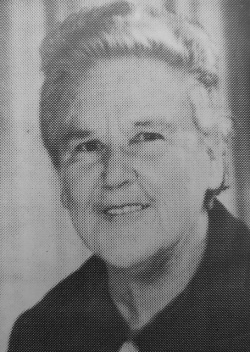Florence May Harding facts for kids
Florence May Harding (born in 1908 – died on August 19, 1971) was a talented Australian woman known as May Harding. She was a teacher, a naturalist (someone who studies nature), a botanist (a plant expert), and an artist. She lived and worked in Broken Hill, New South Wales.
Contents
Early Life and Family
May Harding was born in 1908 in a mining town called Silverton, New South Wales. She was one of three children. Her parents were Frederick Joseph Harding and Florence May Boyle. She had two siblings, Doris and Frederick.
Her family soon moved to Broken Hill. Her father worked there as a foundryman, which means he worked with metals. May lived at 59 Williams Street for most of her life. After her mother passed away in 1935, May took care of her father until he died in 1956. She then lived alone in the same house. May lived a simple life and never married.
A Passion for Nature and Art
May Harding studied art at the National Art School in Sydney. She also learned from artist Douglas Robert Dundas. However, she didn't have formal training in botany (the study of plants).
From a young age, May loved the native plants of the dry West Darling region. She taught herself about plants by collecting and identifying them. She combined her love for plants with her art skills. As early as 1922, she was showing her paintings of wildflowers.
In the 1930s, May became even more interested in the plants around Broken Hill. This was partly because of Albert Morris. He worked hard to control the dust problems in the city. Albert Morris was the first Secretary of the Barrier Field Naturalists' Club in 1918. May Harding later held this position for many years. She was a member of the club for 45 years!
May Harding's Role in the Naturalists' Club
As Secretary, May was very good at organizing events and doing research. She was also the club's librarian and a speaker at meetings. She led many trips to explore nature, both in the local area and further away, like the Flinders Ranges.
In 1944, May was part of the Sturt Memorial Committee. She helped create a special booklet to remember explorer Charles Sturt. She contributed her botanical artwork and helped edit the material. By 1950, May was known across Australia for her knowledge of plants in dry and semi-dry lands.
Teaching and Promoting Art
Between 1940 and 1970, May Harding was the only part-time teacher of art and botany at the Broken Hill Technical College. From 1947, she also taught art classes to about 40 local children on Saturday mornings.
May loved children, and she also had a soft spot for cats. She often had a dozen or more cats relaxing in her home. Her house was filled with her private library and her favorite artworks, including her own and those of other artists she admired.
May was a very skilled artist and graphic designer. She worked with oils and watercolors. While she didn't become famous for her own art, she was very important in promoting other artists from Broken Hill.
Supporting Local Artists
In 1961, May was a founding member of the Willyama Arts Society. She was also its secretary and treasurer, and the only woman on the committee. This society helped launch the careers of local artists like Pro Hart and Sam Byrne. Their success led to the famous group known as the Brushmen of the Bush. Sam Byrne often said that May Harding's advice was very helpful to him.
In 1965, May was chosen to open the Festival of Australian Wildflowers in Canberra. She was also an Honorary Life Member of the Arts Council of Australia (NSW Division).
Lasting Impact
May Harding was a confident yet humble person. She was much loved and respected in the art community of Broken Hill in the mid-20th century. Her lively spirit and dedication helped create the strong art culture that Broken Hill has today.
May Harding passed away from breast cancer in Broken Hill on August 19, 1971. She is buried in the Broken Hill Cemetery. A part of the Broken Hill Regional Art Gallery was named in her honor. A flower show by the Field Naturalists' Club was also dedicated to her after her death. There is even a street in Broken Hill named May Harding Drive. Her work and life are recorded in important Australian art and women's history registers.


